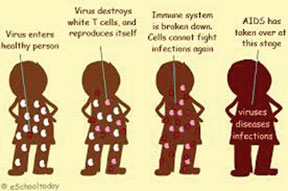
HIV stands for Human Immunodeficiency Virus. It’s the virus that causes HIV infection.
AIDS means Acquired Immunodeficiency Syndrome. AIDS is the most advanced stage of HIV infection.
HIV is transmitted (spread) through the blood, semen, genital fluids, or breast milk of a person infected with HIV. Having unprotected sex or sharing needles and syringes with a person infected with HIV are the most common ways HIV is transmitted.
An infected person can have different amounts of the HIV virus in his or her blood. The amount of HIV in an infected person’s blood is called the viral load.
How HIV Works
Your body has a type of white blood cell called a CD4+ T-helper cell (also called T-cell or CD4 cell). CD4 cells protect you from infection. They are a big part of your immune system. HIV destroys these cells.
When HIV has killed too many CD4 cells, your body can no longer fight off certain infections. These infections are called opportunistic infections.
When HIV-1 enters a healthy CD4+T-cell in the blood, it takes over the “machinery” of the cell to make more copies of itself. This process is called the HIV life cycle.
HIV Treatment
HIV-1 medicines help stop HIV from using the CD4 cell’s machinery to make more copies of the HIV virus. The different HIV-1 medicines do this by interfering with different steps of the HIV life cycle.
The use of multiple HIV-1 medicines is called antiretroviral therapy, or ART.
ART can reduce the viral load and increase the number of infection-fighting CD4 cells in a person’s blood.


Be the first to comment